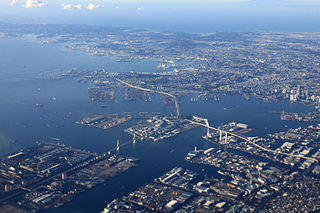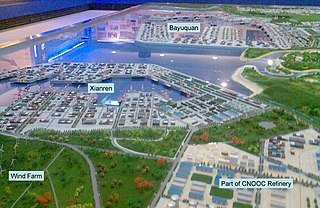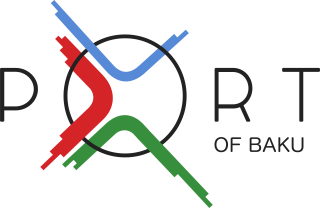
Bahia is one of the 26 states of Brazil, located in the Northeast Region of the country. It is the fourth-largest Brazilian state by population and the 5th-largest by area. Bahia's capital is the city of Salvador, on a spit of land separating the Bay of All Saints from the Atlantic. Once a monarchial stronghold dominated by agricultural, slaving, and ranching interests, Bahia is now a predominantly working-class industrial and agricultural state. The state is home to 7% of the Brazilian population and produces 4.2% of the country's GDP.

Chennai Port, formerly known as Madras Port, is the second largest container port of India, behind Mumbai's Nhava Sheva. The port is the largest one in the Bay of Bengal. It is the third-oldest port among the 13 major ports of India with official port operations beginning in 1881, although maritime trade started much earlier in 1639 on the undeveloped shore. It is an artificial and all-weather port with wet docks. Once a major travel port, it became a major container port in the post-Independence era. An established port of trade of British India since the 1600s, the port remains a primary reason for the economic growth of Tamil Nadu, especially for the manufacturing boom in South India, and has contributed greatly to the development of the city of Chennai. It is due to the existence of the port that the city of Chennai eventually became known as the Gateway of South India.
Kamarajar Port Limited, formerly Ennore Port, is located on the Coromandel Coast, Chennai about 18 km north of Chennai Port. It is the 12th major port of India, and the first port in India which is a public company. The Kamarajar Port Limited is the only corporatised major port and is registered as a company. Chennai Port Trust acquired around 67% stake of Centre in the Kamarajar Port Limited on 27 March 2020. The remaining 23 percent was already held by the Chennai Port Trust.

The Port of Ashdod is one of Israel's three main cargo ports. The port is located in Ashdod, about 40 kilometers south of Tel Aviv, adjoining the mouth of the Lachish River. Its establishment significantly enhanced the country's port capacity. It handles the largest volume of cargo containers annually of all Israeli ports. Ships carrying humanitarian aid for the Gaza Strip also unload their cargo at Ashdod.

Teesport is a large sea port located in the unitary authority of Redcar and Cleveland, in the ceremonial county of North Yorkshire, Northern England.

The Port of Santos is in the city of Santos, state of São Paulo, Brazil. As of 2006, it is the busiest container port in Latin America. In 2016, it was considered the 39th largest port in the world for container handling, and the 35th per ton, according to the AAPA - American Association of Port Authorities ranking, being the busiest in Latin America.

The Port of Yokohama is operated by the Port and Harbor Bureau of the City of Yokohama in Japan. It opens onto Tokyo Bay. The port is located at a latitude of 35.27–00°N and a longitude of 139.38–46°E. To the south lies the Port of Yokosuka; to the north, the ports of Kawasaki and Tokyo.

The Port of Yingkou is an international seaport in Yingkou, Liaoning, People's Republic of China. It is the second-largest port in northeast China and the tenth-largest nationwide. It includes two separate dockland areas, the Yingkou old port at the mouth of the Daliao River, and the Bayuquan port located directly on Liaodong Bay on the Bohai Sea.

In 1961 China established a state-run maritime shipping company and subsequently signed shipping agreements with many countries, laying the foundation for developing the country's ocean transport. That organization developed into the present-day China Ocean Shipping (Group) Company (COSCO). The Chinese government also invested heavily in water transport infrastructure, constructing new ports and rebuilding and enlarging older facilities.
The Port of Zhanjiang is a natural deepwater harbor in Southeast China. It was designed and reconstructed as China's first modern port, the project being commenced in 1956. After nearly 50 years of construction, the existing 39 wharves are able to handle the containers, general cargo and bulk cargo that arrives at the port. It also has facilities for dangerous goods, petroleum, chemicals, liquid chemicals, storage, packaging, commercial and transit passengers, ferries, freight forwarding, shipping agents, ship transport, bonded warehouses and exports. Since 2004, the port has become a land, sea and air transport hub.

The Port of Colombo Sinhala: කොළඹ වරාය, Tamil: கொழும்பு துறைமுகம் is the largest and busiest port in Sri Lanka and the Indian Ocean. Located in Colombo, on the southwestern shores on the Kelani River, it serves as an important terminal in Asia due to its strategic location in the Indian Ocean. During the 1980s, the port underwent rapid modernization with the installation of cranes, gantries and other modern-day terminal requirements.
Manzanillo International Terminal is located east of the Atlantic opening of the Panama Canal on Manzanillo Bay, Colón Province, Panama.

Port of Baku is a sea port located in the Bay of Baku, on the coast of city of Baku, Azerbaijan. The main entrance faces the Neftchiler Avenue.

The Port of Chiba is the largest seaport in Japan, located in Chiba Prefecture on the interior of Tokyo Bay. The Port spans 24,800 hectares across the cities of Ichikawa, Funabashi, Narashino, Chiba, Ichihara, and Sodegaura.

Lekki Deep Sea Port, is a multi-purpose, deep sea port in the Lagos Free Zone and is the only currently operating deep sea port in the country, having started full commercial operations in April 2023.

Mundra Port is India's first private port, largest container port and largest commercial port, located on the northern shores of the Gulf of Kutch near Mundra, Kutch district, Gujarat. Formerly operated by Mundra Port and Special Economic Zone Limited (MPSEZ) owned by Adani Group, it was later expanded into Adani Ports & SEZ Limited (APSEZ) managing several ports. In FY 2020–21, Mundra Port handled 144.4 million tonnes of cargo. The port currently handles over 155 MT, which constitutes nearly 11 per cent of India’s maritime cargo. The port also handles nearly 33 per cent of India’s container traffic.

Marsa Maroc is the main operator of ports in Morocco. Its legal status is a Société Anonyme (Plc.) with an Executive board chaired by Mohammed Abdeljalil and a supervisory board chaired by the Minister of Equipment and Transport. The official company name is Société d'Exploitation des Ports while Marsa Maroc is its trading name.

The Port of Rio de Janeiro is a seaport in the city of Rio de Janeiro, Brazil located in a cove on the west shore of Guanabara Bay. It is the third-busiest port in Brazil, and it is managed by Companhia Docas do Rio de Janeiro.

TransInvestService (TIS) is a large Ukrainian private terminal operator and stevedore operating in the Pivdennyi Port. In 2018, the company's cargo turnover reached 25.7 million tons. TIS operates its own cargo terminals in Small Adzhalyk Estuary, which is in the Pivdennyi Port water area 22 km north-east of Odesa. TIS Group owns five modern terminals: TIS Grain, TIS Mineral Fertilizers, TIS Ore, TIS Coal and TIS Container Terminal. TransInvestService owns and manages all service infrastructure facilities, including an in-house railway station.

In Cikarang, West Java, Indonesia, there is a dry port called Cikarang Dry Port (CDP), which is a part of Kota Jababeka. With a total area of 200 hectares, CDP was founded in 2010. It is run as Indonesia's first and only Integrated Customs Services Zone by PT Cikarang Inland Port, a division of the publicly traded PT Jababeka Tbk. As an inland dry port model, CDP acts as a port extension that addresses ongoing traffic jams and delays at Tanjung Priok, a significant import/export gateway. Reducing the dwelling time from 3.2 days to the government-mandated 2.5 days is the primary goal.


















